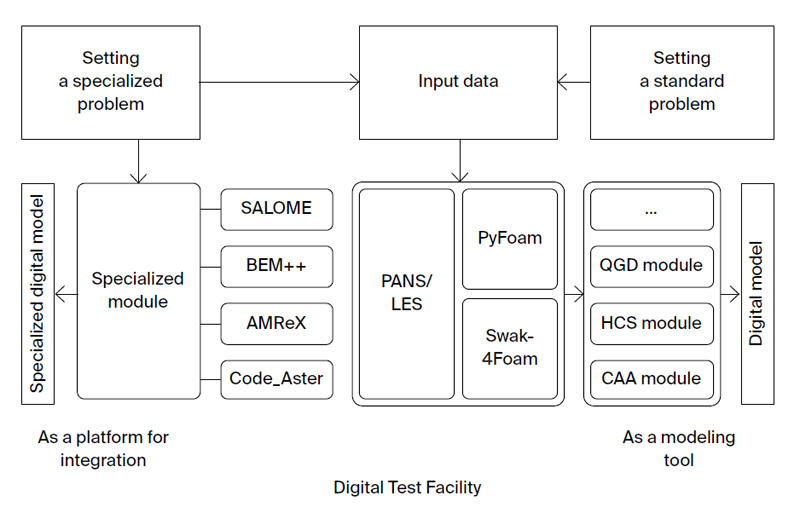Download catalogue of technologies
DigiTEF: a digital twin platform
DigiTEF is a software platform based on OpenFOAM and other open source tools, as well as unique modules and libraries developed at ISP RAS. DigiTEF solves various application problems of gas dynamics, aerodynamics, hydrodynamics, and acoustics. It is tailored for creating and working with highly sophisticated digital models of industrial devices. DigiTEF is included in the Unified Register of Russian Programs (No. 5377).
Features and advantages
The platform delivers the same level of user experience as its competitors worldwide. DigiTEF core performance and accuracy evaluations compared with ANSYS Fluent and Star CCM+ showed similar (and in some cases lower) computational costs with the same accuracy. The community of engineers, researchers, and industrial project developers has been formed around the DigiTEF platform.
DigiTEF means:
- open source code (allows controlling and adapting implemented algorithms);
- the development pace of OpenFOAM+;
- automation tools for computation and model integration that allow integrated research of technical objects;
- possibility of developing additional components according to the specific requirements.
DigiTEF consists of two main blocks:
1. OpenDTE, the platform core based on OpenFOAM. It contains the basic algorithms, procedures, and functions, as well as a set of third-party libraries in C++. It is fully open and can be obtained at https://github.com/unicfdlab. OpenDTEF consists of the following components:
- tools for modeling compressible flows;
- settings setup for advanced cases based on swak4Foam;
- parameterization based on Python. This allows automating calculation cases as well as integrating Salome, ParaView, and CodeAster software systems into DigiTEF.
2. Modules developed at ISP RAS:
- Data analysis for visualizing and retrieving information. It is designed to analyze results and build models of reduced dimension using data processing methods (FFT, POD, DMD, Hilbert transformations).
- Compressible flows simulation based on quasi-gas dynamics (QGD) equations, allowing to use the spatio-temporal averaging procedure to determine the main gas-dynamic quantities (density, velocity, temperature, and others).
- Incompressible flows simulation based on QHD equations. The module is applicable in oceanology, convection, and subsonic flows problems.
- Incompressible and compressible flows simulation based on the Pimple and Kurganov-Tadmore hybrid algorithm.
- Subsonic turbulent flows simulation using the hybrid URANS / LES approach and low dissipative numerical schemes.
- Acoustic analysis. The module implements the Curle and Focs Williams-Hawkings analogies.
- Ice dynamics simulation.
Who are DigiTEF users?
DigiTEF is designed for use in the facility of resource-intensive industries. Using digital twin models allows increasing engineering efficiency as well as reducing costs and complexity of the industrial projects implementation.
Deployment stories
DigiTEF is used in several projects in the fields of wind energy, aerospace, aviation, metallurgy, as well as in the oil and gas industry. DigiTEF open source modules are successfully used in Institut Pprime (France), Korea Atomic Energy Research Institute (Korea), Universität der Bundeswehr München (Germany), Northwestern Polytechnical University (China), Embry-Riddle University (USA), California Institute of Technology (USA), etc.
System requirements
Linux OS. Other operating systems that support the Oracle VirtualBox virtual machine may also be used (on Microsoft Windows 10 via the Bash shell). Moreover, the performance loss due to virtualization does not exceed 5%. Required RAM: 16 Gb or higher.
DigiTEF supports parallel computing, which significantly speeds up its work. Also, it supports high performance computing systems (supercomputers and clusters) to accelerate calculations. Using up to 1536 computational cores was tested.
Workflow

Back to the list of technologies of ISP RAS 


